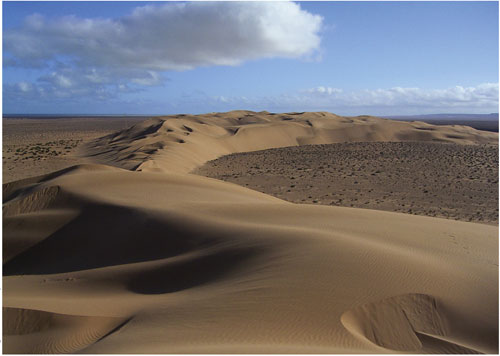Dulcet Dunes
By Fenella Saunders
Self-synchronized avalanches turn piles of sand into musical instruments
Self-synchronized avalanches turn piles of sand into musical instruments

DOI: 10.1511/2006.62.503
The sound is unearthly, a deep drone that is a cross between a hum and a buzz. The volume is also unnerving. "It's about 110 decibels, as loud as the engines of a plane that is going by just above you," says Stéphane Douady. "The human threshold of pain is 120 decibels, so this is really powerful."

Photograph courtesy of Stéphane Douady.
Adding to the tone's otherworldliness is the inability of the human ear to localize the source of the noise. "You can find the direction if the sound's wavelength is shorter than the distance between your two ears," Douady explains. "But here, it's low-frequency sound, more than 3 meters long, so you cannot really find where it is coming from."
What are these strange emanations? They are the songs of sand dunes. Marco Polo observed "singing sands" during his travels in China in the 1200s, as did Charles Darwin in Chile. There are perhaps 100 or so places worldwide where melodious dunes exist.
Investigators have long theorized that the sounds come from grains cascading down the faces of the mounds. Douady, a physicist at the Centre national de la recherche scientifique in Paris, and his colleagues have been delving deeper into dunes in Morocco, Chile, China and Oman, and believe they can now explain the exact mechanism behind this acoustic phenomenon. (Listen to the dunes at http://www.lps.ens.fr/~douady/.)
Sand avalanches don't look like much, nothing like the snow events. But under the surface, sand slides have a lot going on. As the granules get moving, they quickly sift themselves by size: The smaller ones fall through the gaps between their bigger brethren, so larger bits end up on top. A sand avalanche will typically have 20 to 30 such self-sorted strata, says Douady.
As the landslide progresses, the layers gain energy from gravity. But they also slam into the levels below them, producing shock waves that lessen the sand's speed. Thus the tiers converge to a constant velocity. But Douady adds that the friction of the grains during impact also appears to produce a wave that travels through the entire flow, coupling all motion together. As Douady and his colleagues reported in the July 7 issue of Physical Review Letters, soon all the bands have spontaneously begun moving up and down in phase. The result is that the surface pulses like the diaphragm of a speaker, emitting the booming serenade. Without this synchronous undulation, the sand might rustle, but it wouldn't sing.
The group also hauled sand back to the laboratory and set it up in channels with automated pushing plates. The sands still sang, proving that the dune itself was not needed to act as a resonating body for the sound, as some researchers had theorized. The motion is also not really stick-slip, like a violin bow on a string, because that requires two solid surfaces, says Douady.
Dunes typically have a characteristic frequency, determined by their average sand size: The larger the grain, the lower the key. However, Douady's team found that they could get dunes in the wild to hit different notes if they shoved piles of sand faster or slower than the speed normally induced by gravity, or if they moved more material than gravity would release in a natural avalanche.
Douady also found that there is a window of grain speed, above or below which the sand won't perform in nature. Too slow and there's not enough energy to produce shock waves; too fast and the sand doesn't flow but is just flung away.
Height also matters. Douady believes that the coupling wave reflects back and forth inside the flowing avalanche and is only able to synchronize the movement of the sand layers if it returns at the end of one period, so that the peaks and valleys of the waveform line up and reinforce one another. If the height of the sand flow isn't within the correct bounds for this arrangement to happen, the dune may not naturally sing.
There are further complications. The grains have to be well rounded and of a small range of sizes. To make matters worse, Douady found that the sand he had brought back to his lab stopped singing after a month of experiments. After some brainstorming, he realized that all the tuneful dunes are near salt sources. "The best dunes I ever found were in deserts, but close to the sea," he says.
Sure enough, after a saltwater bath and drying, his lab sand was sonorous once more. Douady suspects that the salt catalyzes some kind of veneer on the grains' surface, but he's still looking into why that's necessary. The mysterious dunes, it seems, aren't quite ready yet to give up all of their secrets.
Click "American Scientist" to access home page
American Scientist Comments and Discussion
To discuss our articles or comment on them, please share them and tag American Scientist on social media platforms. Here are links to our profiles on Twitter, Facebook, and LinkedIn.
If we re-share your post, we will moderate comments/discussion following our comments policy.